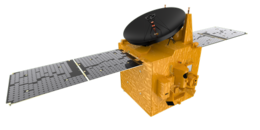
Back Emirates Mars Mission AN مسبار الأمل Arabic Аль-Амаль Byelorussian আমিরাত মঙ্গল অভিযান Bengali/Bangla Emirates Mars Mission BS Emirates Mars Mission Catalan ھیوا (کەشتیی ئاسمانی) CKB Emirates Mars Mission Czech Al-Amal German Misión Hope Mars Spanish
 A 3D rendering of the Hope spacecraft | |
| Names | Hope probe |
|---|---|
| Operator | Mohammed bin Rashid Space Centre |
| COSPAR ID | 2020-047A |
| SATCAT no. | 45918 |
| Website | emiratesmarsmission |
| Mission duration | 1431 days and 10 hours (since orbital insertion) 2 years (planned)[1] |
| Spacecraft properties | |
| Spacecraft | Hope (Arabic: الأمل, Al-Amal) |
| Manufacturer |
|
| Launch mass | 1350 kg, including 800 kg hydrazine fuel[2][3] |
| Dry mass | 550 kg[3] |
| Dimensions | 2.37 m × 2.90 m |
| Power | 1800 watts from two solar panels |
| Start of mission | |
| Launch date | 20 July 2020, 21:58:14 UTC[4] |
| Rocket | H-IIA |
| Launch site | Tanegashima, LP-1 |
| Contractor | Mitsubishi Heavy Industries |
| Orbital parameters | |
| Periareon altitude | 20,000 km (12,000 mi) [5] |
| Apoareon altitude | 43,000 km (27,000 mi) |
| Inclination | Supersynchronous orbit |
| Period | 55 hours |
| Mars orbiter | |
| Orbital insertion | 9 February 2021, 15:30 UTC [6] |
| Instruments | |
| |
 Hope Mars mission logo | |
The Emirates Mars Mission (Arabic: مشروع الإمارات لاستكشاف المريخ, romanized: mašrū' al-Imārāt l-āstikšāf al-Murīkh) is a United Arab Emirates Space Agency uncrewed space exploration mission to Mars. The Hope probe (Arabic: مسبار الأمل, Misbar Al-Amal) was launched on 20 July 2020,[6] and went into orbit around Mars on 9 February 2021.
The project was headed by Omran Sharaf. 200 Emirati scientists and engineers from the UAE and partner institutes were involved in the project. The mission design, development, and operations are led by the Mohammed bin Rashid Space Centre (MBRSC).[7] The spacecraft was assembled in the United States at the University of Colorado Boulder's Laboratory for Atmospheric and Space Physics (LASP) by the Emirati engineers, assisted by their American counterparts, with support from Arizona State University (ASU) and the University of California, Berkeley.[8][9] The project was led by MBRSC at every stage.[10]
The space probe will study daily and seasonal weather cycles, weather events in the lower atmosphere such as dust storms, and how the weather varies in different regions of the planet. It will also add to knowledge about Mars atmospheric hydrogen and oxygen loss and other possible reasons behind the planet's drastic climate changes. The mission is being carried out by a team of Emirati engineers in collaboration with foreign research institutions, and is a contribution towards a knowledge-based economy in the UAE.[11]
Hope was the first of three space missions sent toward Mars during the July 2020 Mars launch window, with missions also launched by the national space agencies of China (Tianwen-1 orbiter, deployable and remote cameras, lander and Zhurong rover) and the United States (Mars 2020 and its Perseverance rover and Ingenuity helicopter drone). The spacecraft was launched from the Tanegashima Space Center in Japan with a Japanese rocket, the Mitsubishi Heavy Industries H-IIA launch vehicle. All three arrived at Mars in February 2021. The Emirates Mars Mission was the first of the three to arrive at Mars, performing a successful orbit entry maneuver on 9 February 2021.[12][13]
On 9 February 2021, the United Arab Emirates became the first Arab country and the fifth country to reach Mars and the second country to successfully enter Mars' orbit on its first try after India. In April 2023, The New York Times reported an updated global map of Mars based on images from the Hope spacecraft.[14]
- ^ "The Journey of Emirates Mars Mission". Archived from the original on 2 November 2016. Retrieved 24 March 2016.
- ^ "Emirates Mars Mission (Hope)". NASA Space Science Data Coordinated Archive. Retrieved 30 November 2022.
- ^ a b "Jonathan's Space Report No. 781 Draft". 19 July 2020. Retrieved 20 July 2020.
- ^ "Emirates Mars Mission". emiratesmarsmission.ae.
- ^ "UAE Unveils Mission Plan for the First Arab Space Probe to Mars". Ministry of Cabinet Affairs. SpaceRef. 7 May 2015. Retrieved 9 May 2015.[permanent dead link]
- ^ a b "Live coverage: Emirates Mars Mission launches from Japan". Spaceflight Now. 19 July 2020. Archived from the original on 19 July 2020. Retrieved 20 July 2020.
- ^ "Emirates Mars Mission". Mohammed bin Rashid Space Centre. 2019. Archived from the original on 28 July 2020. Retrieved 30 July 2020.
- ^ Clark, Stephen (19 July 2020). "United Arab Emirates successfully sends its first mission toward Mars The spacecraft and its three scientific payloads were developed as a collaborative project between scientists at the Mohammed Bin Rashid Space Center, the UAE Space Agency, and three universities in the United States". Archived from the original on 21 July 2020. Retrieved 26 July 2020.
- ^ Chang, Kenneth (15 February 2020). "From Dubai to Mars, With Stops in Colorado and Japan". The New York Times. ISSN 0362-4331. Archived from the original on 15 February 2020. Retrieved 15 February 2020.
- ^ "Everything You Need to Know About CU's Involvement in the Emirates Mars Mission". Alumni Association. 31 March 2021. Retrieved 24 August 2023.
- ^ "UAE positions 2020 Mars Probe as catalyst for a new generation of Arab scientists and engineers". Archived from the original on 7 May 2015.
- ^ "UAE's "Hope" probe to be first in trio of Mars missions". phys.org. Retrieved 8 February 2021.
- ^ Amos, Jonathan (9 February 2021). "Emirates Mars Mission: Hope spacecraft enters orbit". BBC News. Retrieved 9 February 2021.
- ^ Cite error: The named reference
NYT-20230415was invoked but never defined (see the help page).